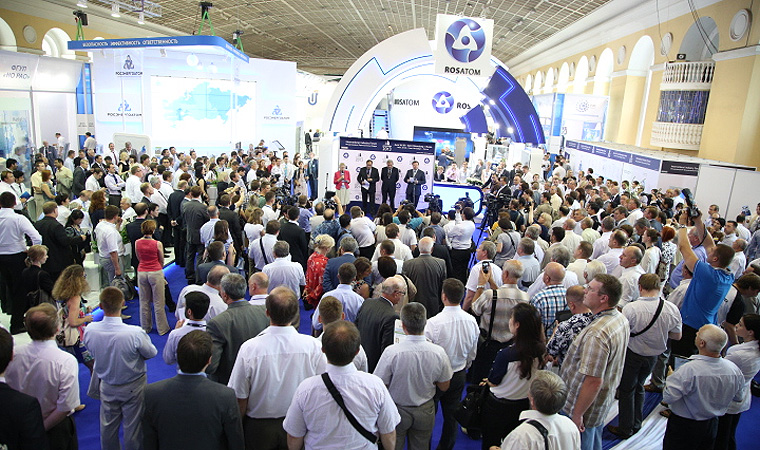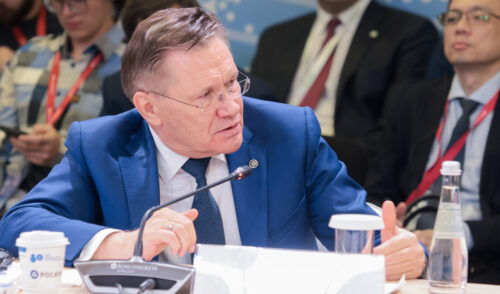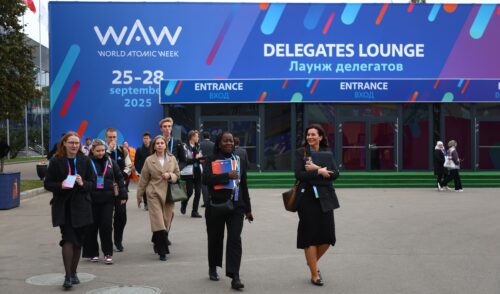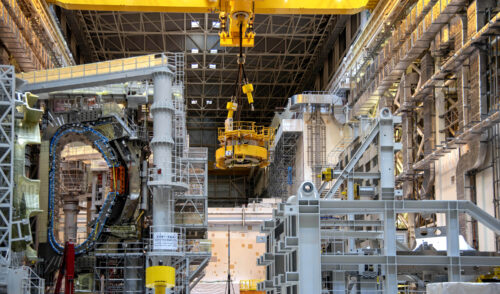
Two In One
back to contentsThe main “Atomexpo” field was organized in Mikhailovsky Manezh. Interactive presentations were prevailing on the stands: one could fly over a virtual NPP, assemble one’s own atomic station on a draw-pad, launch a reactor with the help of a bicycle. The most popular indeed was the Chinese stand where everyone was given a free hand fan. However in the end the demand exceeded supply, just the same as at the fast-growing Asian-region market.
The informative part of the event proved that with more than two years had passed after the Fukushima catastrophe, the atomists these days are more apt to speak not about the consequence, but of the industry’s prospective development, first of all from the point of view of the most demanded technologies. We tried to highlight several key-trends of the “Atomexpo” forum.
It is daily growing
Dzhomart Aliev, “Rusatom Overseas” Director speaking at the round table, dedicated to integrated approach to peaceful atom, gave his prognosis of the atomic generation development in the world. The company expects NPP capacity growth approximately by half by 2030. The growth areas traditionally are China and India with the ME countries and Africa joining them, as Aliev believes. Under conditions of the economic crisis endured by many countries during the recent years, the models like BOO (build – own – operate) and BOT (build – own – transfer) will be used more often. As early as in the seven years period 26 new units, built on these types of schemes, will be launched in the world. Rosatom is ready for this, moreover, as we know, there already is a project of the BOO type – the Akkuyu NPP in Turkey.
Small ones are on trend
Another topic discussed was low and medium power reactors. According to one of the participants of plenary discussion, these types of reactors are soon to become the market’s bestsellers. Rosatom agrees at this point. According to the State Corporation estimations, by 2030 the world scope of installed capacity of these types of reactors will be more than 40 GWt, with the demand of low and medium capacity reactors appearing in Latin America, Africa and Asia.
This technology is also believed to be a good solution in terms of desalination, cogeneration and floating NPPs. A special detailed presentation on small power reactors development was made by Hans Joachim Kopp, a Roland Berger Strategy Consultants Agency partner. Rosatom had the best chance to prevail the future market, he said.
“These reactors have many advantages, – said Yukiya Amano. – They are compact and don’t cost much to produce, they can be fully manufactured at an industrial enterprise, providing efficiency and safety. They work especially well for countries with underdeveloped networks. Besides they are important in terms of nuclear non-proliferation. We are keeping an eye on this sphere”.
Luis Echavarri, OECD Nuclear Energy Agency Director believes the projects of small and medium power are likely to appear on the market within the four-six years period. “We need the scheme of implementation of these reactors’ network infrastructure when there is a lack of money or demand for bigger NPPs”, – he said.
New Oil
On the first day of the forum, after lunch-break, the representatives of 42 states could chill a little bit in a relatively cool Palace Theater not so far from Mikhailovsky Manezh and discuss the prospects of nuclear power on a plenary session. According to the JAIF President Takuya Hattori, by 2035 the population of Earth will increase up to 8,5 billion with the main growth in Africa and Asia. “For our planet’s future stability we need to establish a so-called low-carbon society which can’t be done without new NPPs”, – he said.
Middle East has a big potential for nuclear power. According to Kirill Komarov, Rosatom’s Deputy General Director, Director for International Business and Development, peaceful atom can play a very important part in Arabian East countries, taking into consideration the oil crisis. “Let’s be honest: oil extraction is hardly going to grow, the prices are stuck. You know, as designers say, that this season the purple color is the new black? Just the same I would say: in the XXI century the nuclear power for the Arabian East will be its new oil” – he said. The IAEA conference confirmed this point. “The chief delegates’ reports of Algeria, Saudi Arabia, Nigeria and the UAE, major oil and gas possessors, confirmed that the countries view nuclear power programs development as priority. This proves atom’s competitive ability and its contribution to world energy security” – believes Sergey Kiriyenko, the head of Rosatom.
However the nuclear energy development in these countries depends a lot on how serious their approach to the issue would be, if they manage to establish efficient industrial policy.
In terms of technology
The participants also discussed the technologies to be in the most demand in future. Christophe Behar, Director of the Nuclear Energy Division at the French Atomic Energy Commission (CEA), expressed his country’s position on the point, believing the most promising technologies to be fast breeder reactors and closed nuclear fuel cycle. “However we don’t oppose fast reactors to LRW (light water reactors), – he said. –The former produce plutonium used by the latter with maximum efficiency. Besides, fast breeder reactors save natural uranium resources”.
Alexander Bychkov, the IAEA Deputy General Director, also prognosticated fast reactors growth in the nearest future. However small reactors shouldn’t be forgotten either. “The market is in need of small and medium power reactors, but very few can offer them so far, – Bychkov believes. – Today we have traditional construction technologies, but further on we’ll have to use safer modular systems as well. Thus we have to count all innovations in the field of construction”.
As for Christophe Behar, his position, speaking of small power reactors, seems to be reserved, their competitiveness further to be proved: “There is a big debate on the subject. We have to collect information from all countries and give the issue a thorough study. The analysis of the technology should be continued until its competitiveness is proved”.
Kirill Komarov noted that post-Fukushiman space will demand only the technologies corresponding at least the III+ reactor generation. “I don’t really think something lower than that will be constructed”, – he said. Komarov also emphasized the importance of complex offer: “One should not only build III+ generation NPPs, but also provide efficient infrastructure, such as: personnel training, regulatory system, technology literacy. This is the only acceptable approach and we in Rosatom also believe it necessary and are ready to meet the requirements”.
Luc Oursel, Chief Executive Officer of Areva, invited the participants to establish new recommendations for the work of the III generation reactors and apply them to practice. “We have achieved some good improvement, new types of technologies, able to protect us from accidents equal to the Fukushiman, have appeared”, – he said.
According to the tradition, the participants of the “Atomexpo-2013” plenary session took part in interactive voting. 34% of the audience agreed that the fast breeder reactors are to become the main technological trend in the industry, 72% believed China and India to become the point of growth of atomic energy in the new century.
Came into line
Sergey Kiriyenko, the head of Rosatom, summarized the issues discussed at the IEAE conference and “Atomexpo” forum at the final press-conference: “During the recent years many new countries have become convinced in necessity of nuclear power development. It is impossible to provide world economic stability without adding it to energy balance. That’s what the representatives of most countries were speaking about”.
According to Kiriyenko, as many as 87 national delegations and five international organizations attended the IAEA conference, while the “Atomexpo” forum united the representatives of 42 countries. “It is very important that the opinions expressed by Ministers at the IAEA conference and those of the business-society at “Atomexpo” concerning the necessity and priority of atomic energy happened to be the same”, – emphasized the head of Rosatom. The speeches of participants confirmed the reasons why the countries believe atomic energy development to be the matter of crucial importance: stability and predictability of electric energy prices, reduction of dependence on energy-carriers’ cost fluctuations and reducing greenhouse gas emissions, added Kiriyenko.




